Definition: Service marketing refers to the application of a different set of tactics or strategies to anticipate the consumer’s need for an intangible product. And thus, meet their requirements accordingly, to create maximum value for them from their purchase.
The marketing of services is different from the marketing of products. While selling off services, convincing the consumers and pricing the intangible products is a challenging task.
Content: Service Marketing
Paradigm in Service Marketing
The present marketing scenario is a lot more different from what it used to be earlier. The belief, mindset, perception and attitude of the consumers have changed tremendously.
Discussed below are the new set of paradigm for modern marketing in terms of services:
Service Categories
Service industry seems to be more complicated than the manufacturing industry. The services can be either tangible or intangible; people-oriented or product oriented.
These are further classified into the following four major categories based on their applicability:
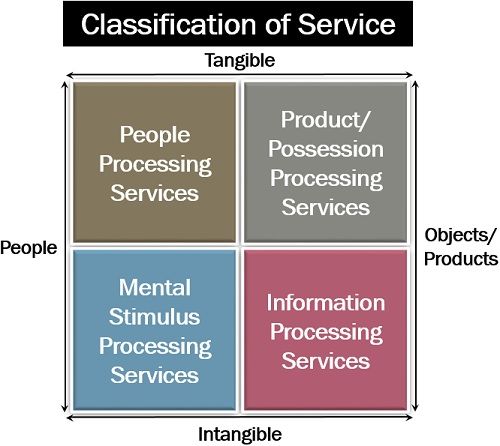
People Processing Services: People processing here refers to the physical presence of the customer at the service system or location, to avail the service. For example, a person needs to be physically present at the ‘salon’ to get a hair cut.
Product/Possession Processing Services: Such services are related to a specific product or its possession with limited or no involvement of the customer. For instance, the services offered by ‘packers and movers’ are primarily concerned with the safe shifting of customer’s belongings, i.e., furniture and assets from one place to another.
Mental Stimulus Processing Services: The services which influence the consumer’s mental abilities, religious believes, behaviour, perception, lifestyle and attitude are termed as mental stimulus processing services. Like, educational institutes deliver knowledge which develops the mental ability of a person.
Information Processing Services: These are a unique form of intangible products where the information acts as a product, or information technology is used. Such decisions are considered to be critical due to massive investment and a high level of risk; therefore, absolute customer involvement can be seen over here.
Customer Oriented
In the service industry, customization of the product offering becomes essential as compared to that of the manufacturing industry. The customer’s needs, perception and requirements are given significance while carrying out the business operations in as a service provider.
Single Take
Service is a one-take action, i.e., it cannot be restored, redone, replaced or exchanged. It is intangible and irreversible; thus, it needs to be perfect and well-delivered at the first time itself.
An organization, therefore, requires trained and experienced personnel to provide services because a lousy consumer experience may lead to negative publicity, which affects the brand name and equity.
Service as a Process
In the service industry, the process plays an important role. The process here refers to the steps involved in availing the service by the consumer.
An organization must keep a watch over each of these steps. It must ensure humbleness, honesty and sincerity of the personnel involved in the interaction with the consumers, while the execution of each of these steps.
Speed and Accuracy
The consumers prefer prompt services without any interruption. Therefore, the rate with which the service is provided is considered as a parameter for efficient service. It is also responsible for the selection of one service provider over the other, by the consumers.
Characteristics of Service Marketing
Services are very different from goods or tangible products, and so is its marketing needs. The general marketing strategies may not apply to the marketing of intangible products.
Some of the basic features which differentiate service marketing from the usual marketing are as follows:
Intangibility
The service is considered as an intangible product which cannot be seen or touched or physically felt but can only be experienced.
In case of a service, the consumer’s buying decision is wholly based on his understanding of the service offering. He/she spends ample time and efforts in decision making, especially for those services which involve huge investment and risk.
The marketer’s assurance on the performance of the service influences the consumer’s decision. However, even a little negative publicity may lead to consumer turnover.
Use of Tangible Products
The service providers make use of various tangible or real products to deliver appropriate service to the consumers. The products absorbed for providing services create value for the customers.
For instance, a travel agent needs to book train tickets (which are usually available in a physical form) for the clients. Thus, the traveller’s experience of the journey is based on the ticket available with him/her.
No Stock Maintenance
The services are intangible and are provided then and there; thus, unlike products, no inventory needs to be maintained in such cases. The profitability in the service industry depends upon the excellence of the service provider and business operations.
For example, a photographer is known for his/her skills, clicks and portfolio, and he/she doesn’t need to maintain any stock. On the contrary, a person selling cameras and albums is known for the product quality and needs to keep sufficient inventory.
Low Price Sensitivity
When we talk about the service industry, we see that the consumers are not price-conscious but are more concerned about the quality of service they get. A zero-defect service product has the highest earning potential.
Thus, we can say that consumer’s price sensitivity towards service is inversely related to the level of performance expectation. Please refer the following graph depicting price sensitivity in service marketing:
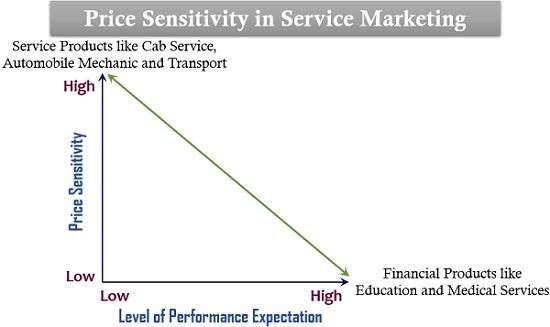
On analyzing the above diagram, we observed that,
In the case of service products like vehicle mechanic, the price sensitivity is quite high. Even though the level of performance expectation is low (i.e., there is a scope of resilience to imperfection).
However, in financial products like education, there is little price sensitivity, but the level of performance expectation is quite high (with zero tolerance to imperfection).
Value Creation Process
The four significant elements or 4P’s of a service which is responsible for consumer satisfaction and value creation are the paces, people, proof and process involved.
The service marketing mix constitutes of these elements along with the traditional marketing mix elements, i.e., product, price, promotion and place.
For instance, ola cab services are known for the instant booking of cabs, humble drivers, facility of ‘one-time password’ and easy app accessibility.
Service Marketing Triangle
Christian Gronroos initially developed the service marketing triangle model in the year 2000. It depicts the relationship between three essential elements of a service industry, i.e., company, employees and consumers.
It emphasizes on the division of the marketing tasks into following three categories based on the required skills, strategies and priorities for service marketing:
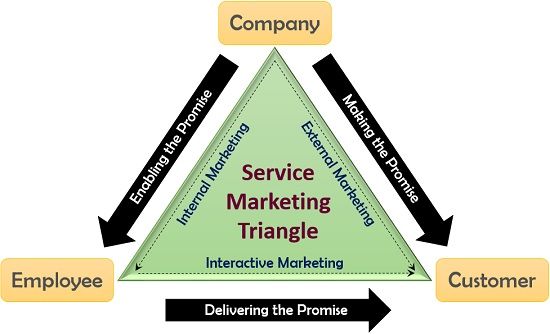
Internal Marketing
The internal marketing connects the company with the employees where the employees are assisted, guided and trained for providing the services to the customers.
The employees are introduced to the organizational goals, and their queries or problems are resolved. The best performers are even appreciated through the performance reward system.
External Marketing
This is the direct form of service marketing. Here the company reaches out to the target consumers through website, advertisements, social media and other relevant platforms, to keep the business rolling.
Interactive Marketing
One of the most crucial marketing tasks is the actual delivery of services to the consumer by the employees. The success of interactive marketing depends upon the proper execution of internal and external marketing.
The employees aim at consumer satisfaction, long-term association and customer retention in interactive marketing. The image of the company is in the hands of the employees.
When some business sectors are purely engaged in intangible products, the others either deal in 100% tangible products or include both real and intangible products.
The service industry has immensely evolved in recent years to provide assistance to the manufacturing industry and also contribute to the development of the economy.
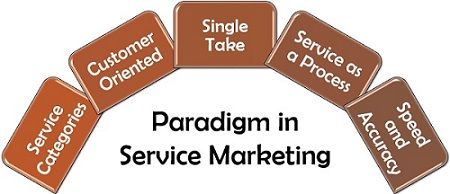
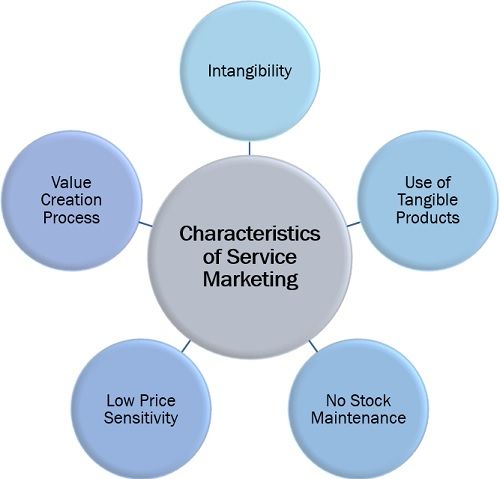
Ijetunge says
Very informative and productive learning tool
Wjetunge says
Very informative and productive learning tool
leval Ainah says
Thanks for your excellent and relevant article. This article has given me some ideas to work on. You have covered extremely important points. Thanks for sharing
Aman says
It has everything which I need.
Amazing
David Walker says
thank you
Sudhansu says
Very well written on service marketing.